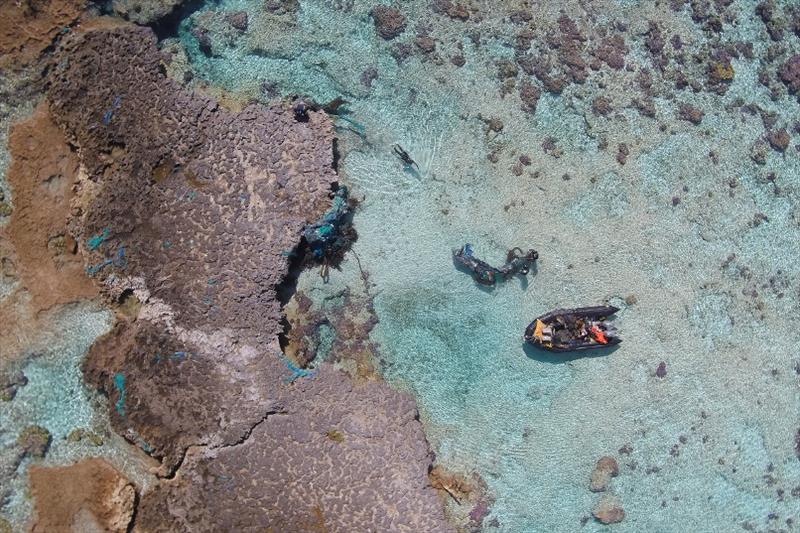
Wrapping up marine debris mission at Midway
by NOAA Fisheries 2 Dec 2018 13:35 UTC

Aerial image of the team removing derelict fishing nets from the reef at Midway Atoll © NOAA Fisheries / Steven Gnam
We started off strong with most of our team at Midway Atoll and finished up with a smaller team of the "Midway Furious Five".
The five of us had amazing weather for the rest of the mission—little to no rain or wind, which meant it was hot while we cleaned up the beaches. Luckily for us, the calm and cool waters were always welcoming, cooling us off between cleaning or loading our boat full of land debris.
One day, we were walking along a beach on Sand Island, and saw a bird struggling ahead of us. When we approached, we realized that this bird, a booby, had part of an eel cone around his body, holding his wings down so he could not move or fly. Our team acted quickly to free the booby by carefully restraining him while we cut the plastic ring off.
After removing the ring, he stood there by our team for a few minutes, seemingly confused about what had just happened to him. We like to think he was grateful for our intervention, but the ultimate truth is that we, as humans, did this to him. Luckily, our team was there to free the bird and see him fly away, mostly unharmed. Entanglement hazards for wildlife from marine debris are very real and, unfortunately, too common. During our mission, we also disentangled several sea turtles and seabirds. We removed derelict fishing nets and debris that Hawaiian monk seal pups were curiously and precariously playing in and around.
Overall, it took our team of five about six days to clean the beaches of Sand Island. The Midway Furious Five collected more than 25,000 pounds of debris in the last 10 days we were on Midway, plus the 30,000 pounds that our whole team collected—totaling over 55,000 pounds on Midway alone!
As we boarded our plane to head back to Honolulu, we all reflected on the last few weeks. While we are super fortunate to spend so much time at Midway and clean the ocean and beaches, we feel a sense of urgency to change our personal habits and influence others to do the same. Looking back at the beaches we had just cleaned, and tallying the amount of plastics and nets we collected felt like such a great accomplishment until, only days later, we would return to see plastics already accumulating again. I could even see some plastics floating, heading towards the islands, from the air.
While the beaches are much cleaner, you still probably wouldn't guess that we had just picked all the plastics and nets, let alone believe your eyes when you saw the piles we collected from them! Beach clean-ups are extremely important, but overall, we need to reduce or eliminate our plastic use or else we will forever be fighting this never-ending battle.
Our marine debris team is very hopeful and excited for the future! We were not necessarily ready to go back home yet but were, at the same time, excited to come home and share our experiences from the mission with family and friends. Stay tuned for our totals from the mission, more experiences post-mission, our outreach events with students, lessons we learned, and how you can help (after all, marine debris really is everyone's problem).